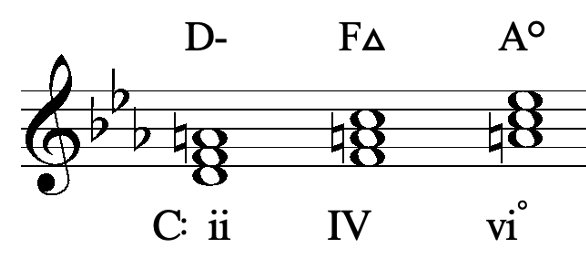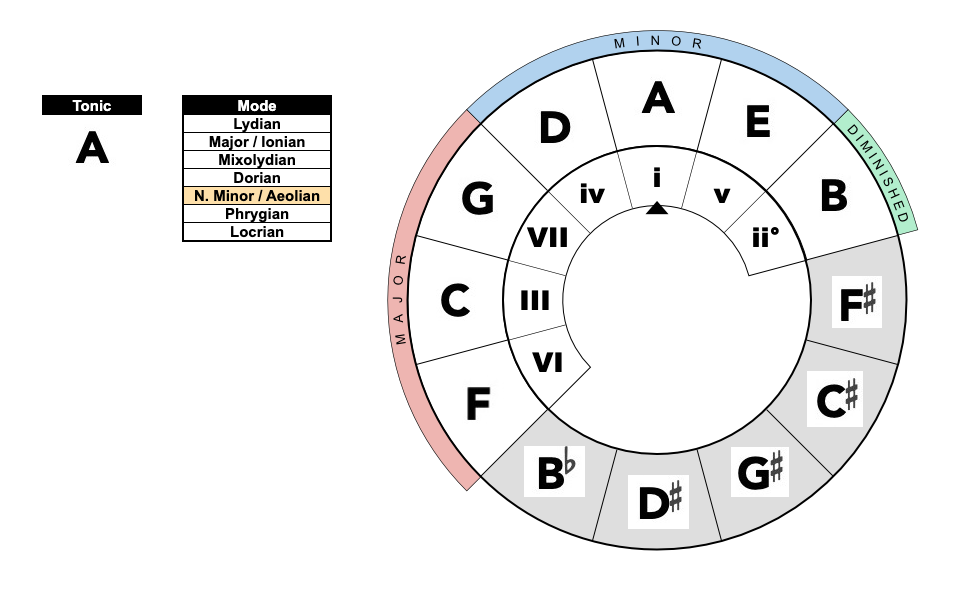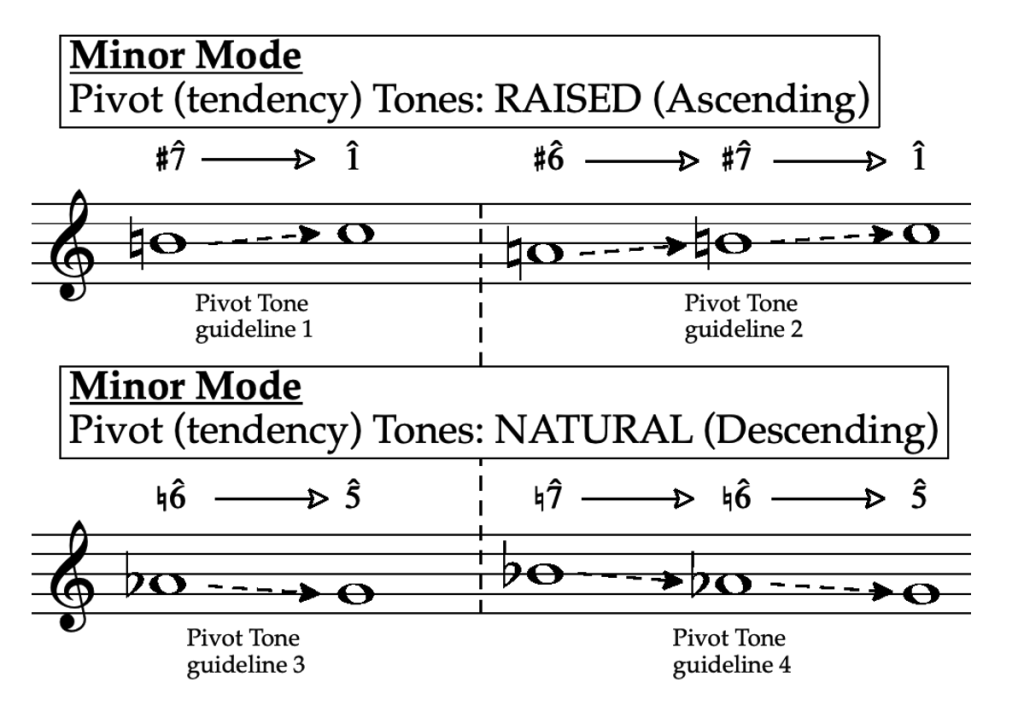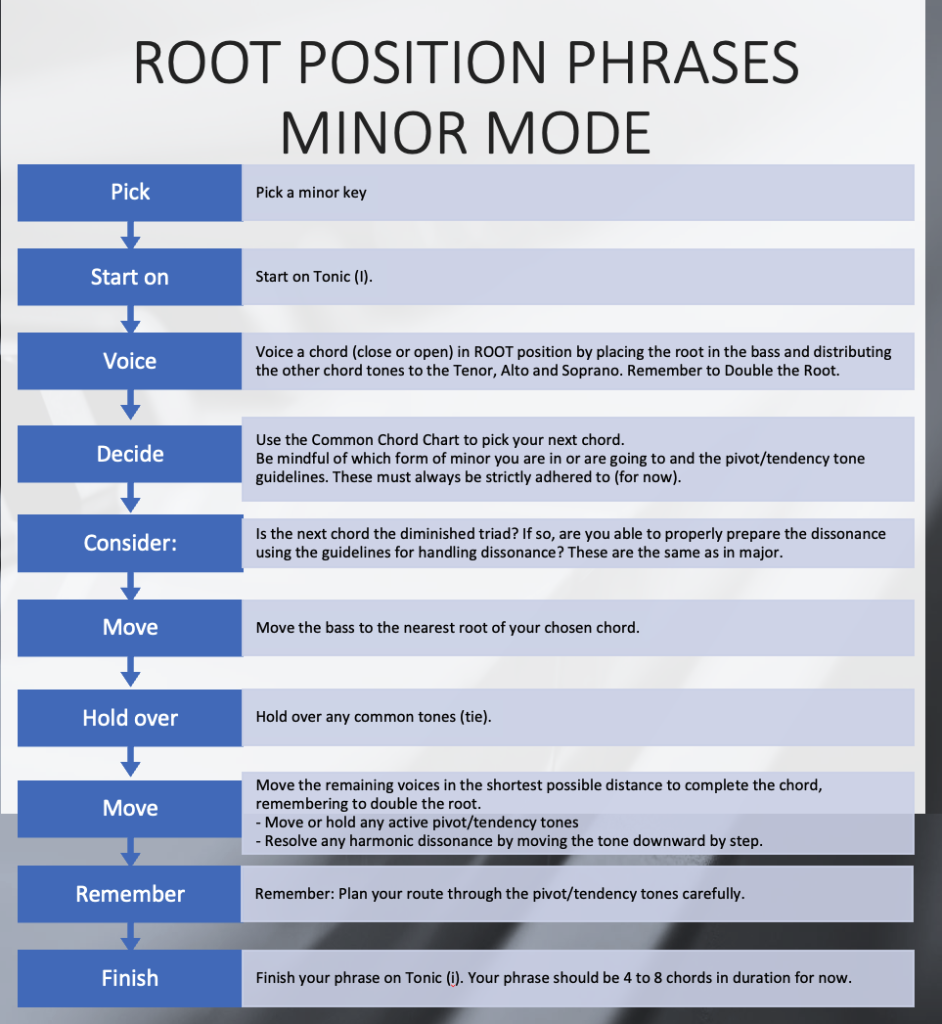Western Harmonic Practice I: Diatonic Tonality
11 The Minor Mode I: Introduction and Characteristics
Key Points
The chapter introduces the modern minor mode, blending historical context with practical guidelines, helping the music student grasp the depth and utility of the minor mode in tonal music. With roots in the Aeolian mode and influences from Dorian and Phrygian, the tonal minor mode offers diverse ‘flavors’ and specific voice leading guidelines crucial to highlight the characteristic sound of the minor mode.
We will cover:
The Three “Flavors” of the Modern Tonal Minor Mode:
- Natural Minor (Aeolian): An unaltered version of the Aeolian mode.
- Harmonic Minor: A variation of the natural minor with a raised seventh scale degree.
- Melodic Minor: Altered with raised sixth and seventh scale degrees when ascending; reverts to natural minor when descending.
The Minor Mode in Practice:
- Seamless integration of all three minor mode scales in musical compositions as a composite mode.
- Voice leading as an indicator of the mode’s form, either Ascending or Descending.
Harmony in the Minor Mode:
- The presence of varied triads stemming from the dual nature of the modern minor mode.
- Introduction to the distinctive Augmented Triad.
Voice Leading Guidelines in the Minor Mode:
- Highlighting pivot/tendency tones and their voice leading characteristics.
- Emphasizing the trajectory and characteristics of both raised (Ascending) and natural (Descending) tones.
Constructing SATB Phrases in Minor:
- Initial application of root position triads.
- Meticulous handling of tendency/pivot tones aligned with voice leading principles.
- Avoidance of any chromatic voice leading.
PODCAST SUMMARY: The Minor Mode
Until now, our study of tonal music has focused on materials and techniques using only one of the seven diatonic modes: the major mode. However, in tonal music, we also have another mode available to us: the minor mode. The modern, tonal minor mode slowly evolved through compositional and performance practices, using the Aeolian mode as a foundation, borrowing elements from the other two minor-like diatonic modes of Dorian and Phrygian. One might reasonably ask why it was necessary to wait until now to begin our study of the minor mode but, as you will see, because it shares characteristics of all the diatonic minor-like modes, it contains peculiar features and characteristics which need more care and attention in practice to use and understand the mode effectively, and to obtain the unique sound and flavor of minor to which it offers.
First, to refresh our memories, let us look at the minor mode Circle of Fifths as we would have learned in our music fundamentals study:
In the above diagram, pitch class A is placed at the top of the circle and thus will have a key signature of no sharps and no flats. The diagram also shows where the chords are located and what type of chords we get (at least in context of natural, modal minor–more on this below).
The “Flavors” of Tonal Minor
As mentioned above, the modern, tonal minor mode evolved through compositional and performance practice over several centuries in Western music to incorporate aspects of each of the diatonic minor-like modes. As you may recall from your fundamentals study, there are three possible configurations of the tonal minor mode: Natural, Harmonic, and Melodic. These three terms refer to the ways in which each variation is deployed within a musical setting. First, let us first quickly review each one.
I. Natural Minor (Aeolian)
So-called “natural” minor is simply the unaltered version of the diatonic Aeolian mode.

Figure 1. Natural Minor, in scale order, built on pitch class A.
II. Harmonic Minor
The first variation of natural minor is known as “Harmonic” minor. It is the natural minor mode with a raised seventh scale degree.
 Figure 2. Harmonic Minor, in scale order, built on pitch class A.
Figure 2. Harmonic Minor, in scale order, built on pitch class A.
As you likely learned during your study of music fundamentals, natural minor does not contain a leading tone but rather a subtonic with ![]() a whole step below the tonic. This is one of a few important differences between the major mode and the minor mode. In Harmonic minor, the
a whole step below the tonic. This is one of a few important differences between the major mode and the minor mode. In Harmonic minor, the ![]() is raised by a half-step, creating an artificial leading tone which then gives us the ability to have a strong tonal harmonic progression in cadences, similarly to how the major mode behaves intrinsically (as we will learn more about shortly). It this use of the artificially created leading tone in harmonic progressions that give this variation its name (“harmonic”).
is raised by a half-step, creating an artificial leading tone which then gives us the ability to have a strong tonal harmonic progression in cadences, similarly to how the major mode behaves intrinsically (as we will learn more about shortly). It this use of the artificially created leading tone in harmonic progressions that give this variation its name (“harmonic”).
III. Melodic Minor
The second variation of natural minor is known as “Melodic” minor. It is the natural minor mode with a raised seventh scale degree, just as we have in Harmonic minor, but also contains a raised sixth scale degree.
 Figure 3. Melodic Minor, in scale order, built on pitch class A.
Figure 3. Melodic Minor, in scale order, built on pitch class A.
Like Harmonic minor shown above, Melodic minor also contains an artificial leading tone by way of a raised ![]() for the purpose of strong tonal cadential progressions. However, unlike Harmonic minor, the Melodic minor variation adds a raised
for the purpose of strong tonal cadential progressions. However, unlike Harmonic minor, the Melodic minor variation adds a raised ![]() which now smooths out the awkward interval of an augmented second (A2) between
which now smooths out the awkward interval of an augmented second (A2) between ![]() and
and ![]() that we find in Harmonic minor[1]. Now, instead of the augmented second between 6 and 7, we have a smoother melodic interval of a whole step. Hence, the name “melodic” simply refers to this smoothing out of the augmented second we find in Harmonic minor.
that we find in Harmonic minor[1]. Now, instead of the augmented second between 6 and 7, we have a smoother melodic interval of a whole step. Hence, the name “melodic” simply refers to this smoothing out of the augmented second we find in Harmonic minor.
The Minor Mode in Context I: Voice Leading
Now that we have an understanding of the three “flavors” of the modern, tonal minor mode, we can begin to consider how these are used in a musical context.
The Ascending and Descending Forms
In practice, the minor mode is used as composite mode, existing in different flavors concurrently in a piece of music or song. This composite form, in essence, allows the mode to express all three of the different scales (natural, harmonic, melodic) as one. How this is achieved is by way of voice leading and, in particular, the direction a voice moves will dictate which form of minor is in operation at any given time: upwards (ascending) and downwards (descending). You may have already learned this idea in a basic way in music fundamentals as, oftentimes, the minor mode is will be taught as a scale with the melodic minor version going upward and the Natural minor going downward.
Figure 4. The Ascending and Descending composite form of Minor, in scale order, built on pitch class C.
This concept is very important, and one we will be slowly getting comfortable in our first harmonic progressions using minor. Mastering and understanding this concept, the concept of voice leading and using the different forms of the mode depending on the direction of a given voice, will give you not only an understanding of minor, but make your musical phrases sound characteristic of minor as well.
The Minor Mode in Context II: Harmony – The Triads of Minor
As with the major mode, we may also construct chords on each of the scale degrees of modern minor. As you might expect, given that we have multiple ways of expressing the mode via the different forms of ascending and descending, we have more possibilities in minor than in major. In fact, it is these differences, and when they appear in context of a musical phrase, that give minor its unique and characteristic sound. As with our exploration of the major mode, we will, at first, work only with triads; later we will explore the many different possible seventh chords which are possible in minor.
In the Ascending form of minor, and derived from Harmonic minor, the raised seventh scale degree (![]() ), provides us three different, altered triads than we would normally have in the Descending (Natural) form. Each of these chords contain the raised
), provides us three different, altered triads than we would normally have in the Descending (Natural) form. Each of these chords contain the raised ![]() as a chord tone. The triads are built on scale degrees
as a chord tone. The triads are built on scale degrees ![]() ,
, ![]() , and
, and ![]() respectively:
respectively:
 Figure 5. The three altered triads from Harmonic minor in the key of C minor.
Figure 5. The three altered triads from Harmonic minor in the key of C minor.
Continuing onward, also in the Ascending form of minor, derived from Melodic minor with the raised sixth scale degree (![]() ), we also get three different altered triads than we would have in the Descending (Natural) form, each of which containing the raised
), we also get three different altered triads than we would have in the Descending (Natural) form, each of which containing the raised ![]() scale degree, and built on scale degrees
scale degree, and built on scale degrees ![]() ,
, ![]() , and
, and ![]() :
:
 Figure 6. The three altered triads from Melodic minor in the key of C minor.
Figure 6. The three altered triads from Melodic minor in the key of C minor.
Now, when we put all of this together, along with the seven triads from the Descending form of minor, we get the complete picture of all of the triads possible in modern, tonal minor:
Figure 7. All of the triads built on each of the scale degrees of Ascending and Descending tonal minor, shown here in the key of C minor.
A New Chord: The Augmented Triad
In the Ascending form of the minor mode we get a new triad which we’ve not yet had a chance to use: The Augmented Triad. This chord is constructed on the Mediant (![]() ) when in the Ascending form of minor.
) when in the Ascending form of minor.
As with the diminished triad, we have no stable perfect fifth between the root and fifth chord tones. Instead we have an augmented fifth (A5) and this is the reason the chord is so named. Older music theory treatises often treated this chord much the same way as a harmonic dissonance, with guidelines surrounding the introduction of the augmented fifth of the chord. However, for our purposes, all of this is taken care of by way of our careful handling of the pivot/tendency tones in minor (explained below).
The Minor Mode in Context: Voice Leading Guidelines
Now that we’ve reviewed the construction and different forms of the modern minor mode, we can begin our exploration historical and best practices of how to use the mode in our own work, first, as we did with the major mode, in the form of very short four part SATB chorale style phrases. In summary, the modern minor mode has evolved to contain two variable scale degrees: (![]() and (
and (![]() . When composing phrases in the minor mode, these variable degrees may either be in their Descending (Natural) form, or the Ascending form with these degrees raised by a half step. We refer to these two variable scale degrees as pivot tones as these scale degrees, now in the form of specific tones in a given key, are points which we move between and engage either the Ascending or Descending form of minor.
. When composing phrases in the minor mode, these variable degrees may either be in their Descending (Natural) form, or the Ascending form with these degrees raised by a half step. We refer to these two variable scale degrees as pivot tones as these scale degrees, now in the form of specific tones in a given key, are points which we move between and engage either the Ascending or Descending form of minor.
As you might expect, best practices and characteristic use of minor do not allow free and haphazard moves between the two forms. Rather, we will carefully treat each form and the use of the pivot tones in our phrases within the following four primary guidelines governing the pivot tones:
Figure 8. The Four Guidelines for the two minor mode pivot tones (Scale degrees ![]() and
and ![]() )
)
It is important to note that, while we often label these two variable scale degrees in minor as pivot tones, it may be more appropriate to call them tendency tones (or “active notes”) as they have a built in tendency to voice lead in one direction or the other with raised tendency (pivot) tones “wanting” to go upward and natural tendency (pivot) tones “wanting” to move downward. It does not matter which term you use but moreover to understand the process and how best to use these tones in a song/piece or phrase written using the minor mode.
Highlighting these guidelines, if we are in the key of C minor, we can see how the pivot/tendency tones are handled:
Figure 9. The minor mode pivot tone guidelines illustrated within the key of C minor.
Constructing SATB Chorale Style Phrases in Minor
- Raised
 must lead (eventually) to
must lead (eventually) to  /
/ 
- Raised
 must lead (eventually) to Raised
must lead (eventually) to Raised 
- Natural
 must lead (eventually) to
must lead (eventually) to 
- Natural
 must lead (eventually) to Natural
must lead (eventually) to Natural 
In addition:
- The pivot/tendency tones should be led according to the four guidelines in the same voice in which the given pivot/tendency tone appears.
- Moving into or out of either of the raised scale degrees from the Ascending form of minor must be done without the use of any augmented or diminished melodic interval apart from the tritone (only if used sparingly)
- Chromatic voice leading, including chromatic cross-relationships (chromatic voice leading in different voices of adjacent chords) is prohibited. Example, natural
 mat not be followed by a raised
mat not be followed by a raised  , or visa-versa, etc.
, or visa-versa, etc. - It is permissible to double the pivot/tendency tones. In this case, however, you must choose which voice assumes the responsibility for continuing the pivot/tendency tone voice leading. Think of this like a “hand off” in football. The other voice then may freely move so long as the melodic interval into or out of that note does not contain an augmented or diminished interval (except for a tritone as mentioned above).
- Occasional freer treatment of the pivot/tendency tones that are in Natural minor (from the Descending form of minor) escending) may be used when a chord is preceded, or followed containing scale degree
 or
or  (or both as in the case of the tonic triad). These tones (five and one) have the effect of resting and may be used as places to cadence (end) or reset the movement between the two minor mode forms.
(or both as in the case of the tonic triad). These tones (five and one) have the effect of resting and may be used as places to cadence (end) or reset the movement between the two minor mode forms.
Taking these pivot/tendency tones into consideration, let’s examine our phrase construction flowchart once again:
Common Tone Chord Chart: Triads (Minor Mode)
| Chord | Has common tones with... | |||||||
|---|---|---|---|---|---|---|---|---|
| i | III | III+( |
iv | IV ( |
v | V ( |
VI | vi ( |
| ii | v | V ( |
||||||
| ii ( |
IV ( |
V ( |
vii ( |
|||||
| III | v | VI | VII | *i | ||||
| III+ ( |
V ( |
vii ( |
i | VI | ||||
| iv | VI | *VII | i | *ii | ||||
| IV ( |
vii ( |
ii ( |
||||||
| v | VII | *i | III | |||||
| V ( |
i | III+ ( |
||||||
| VI | i | ii | *III | III+ ( |
iv | |||
| vi ( |
ii ( |
|||||||
| VII | III | iv | v | |||||
| vii ( |
III+ ( |
iv | *IV ( |
V ( |
||||
A chart of chords (triads) in the tonal minor mode which have at least one tone in common and are permissible with the voice leading guidelines of the pivot/tendency tones in the minor mode. Chords show in bold are from the Ascending form of minor (harmonic/melodic) along with the active scale degree shown for further clarity. The asterisk (*) shows either a connection in the Natural (descending) form of minor where the downward motion of the natural pivot/tendency tone is avoided or a move (italicized) that does not properly prepare or resolve the diminished fifth dissonance. Both are to be avoided until we relax the guidelines and have a freer treatment of both the Natural form of minor and the diminished fifth dissonance.
EXAMPLES: Root Position Triads in the Minor Mode
If the score above is not displaying properly you may CLICK HERE to open it in a new window.
RWU EXERCISES
Root Position Triads in the Minor Mode – Short Phrases
Using the templates below, do the following:
- Compose three harmonic progressions of your choice, at least 4 to 8 chords in length, one may be in A Minor, and the other two any minor key of your choosing.
- Follow very carefully the guidelines above concerning the pivot/tendency tones. Do not forget to prepare and resolve any diminished triad properly as well. Best to plan ahead and be aware of which pivot/tendency tones are active while composing your phrase from start to finish. You must (as always) end on the minor tonic (i) chord.
(you must be logged into your Noteflight account to open the activity templates above)
Schoenberg Theory of Harmony Examples
Schoenberg does not provide full phrases in root position for the minor mode. He does, however, provide examples of various connections between different scale degrees and discusses the pros and cons of these connections in context of the pivot/tendency tone guidelines.
Further Reading
- Schoenberg, Arnold: Theory of Harmony
- Schoenberg, Arnold: Structural Functions of Harmony
- This awkward augmented second is sometimes dubbed as "non melodic" which is something of a misnomer ↵
In tonal music, the term "minor mode" refers to the use of the diatonic Aeolian mode in combination with two variations: Harmonic (raised 7th scale degree) and Melodic (raised 6th and 7th scale degrees). The use of these flavors, in context, provides the overall sense and feeling we hear as minor in both modern tonal music and music from the Western "common practice" period (in the 18th and 19th centuries)
Music, often of the Western tradition, that is organized around a particular pitch class, operating within one of the two modern diatonic modes: major and minor. The harmony often flows according to tonal functions with progressive movement in tension and relaxation via dissonance in relationships to roots and scale degrees.
A diatonic mode that follows the pattern W–H–W–W–H–W–W. This is like the natural minor scale. This scale can also be found by playing the white notes of the piano starting on A.
A diatonic mode that follows the pattern W–H–W–W–W–H–W. This is like the natural minor scale, but with a raised 6̂. This scale can also be found by playing the white notes of the piano starting on D.
A diatonic mode that follows the pattern H–W–W–W–H–W–W. This is like the natural minor scale, but with a lowered 2̂. This scale can also be found by playing the white notes of the piano starting on E.
An ordered collection of half steps (H) and whole steps (W) with the ascending succession W–H–W–W–H–W–W.
An ordered collection of half and whole steps with the ascending succession W–H–W–W–H–3Hs–H. Like natural minor, but with a raised 7̂.
An ordered collection of half steps (H) and whole steps (W) with the ascending succession W–H–W–W–W–W–H and the descending succession W–W–H–W–W–H–W.
A triad whose third is major and fifth is augmented.
Relating in some sense to the chromatic scale. The term may be used to refer to notes that are outside the given key.
A seven note scale that follows the pattern of whole and half steps W–W–H–W–W–W–H. Since there are seven, there are in effect, seven different "modes" -- places we can start and thus rotate the pattern of whole and half steps.
Diatonic further refers to any music that is only made of the seven pitches derived from the local mode/key (as opposed to "chromatic" notes which fall outside any of those seven notes).
A group of pitches that are octave equivalent and enharmonically equivalent.
The relative position of a note within a diatonic scale. Indicated with a number, 1–7, that indicates this position relative to the tonic of that scale.
A 7̂ that is one half step below 1̂. The leading tone is diatonic in major keys, but requires an accidental in minor keys.
The non raised seventh scale degree in minor modes (te, 7̂), or the triad built upon that scale degree (VII).
The home note or home chord of a scale, or something with the function of that home note.
A melodic and harmonic goal. In classical tonal music, cadence types include Perfect Authentic (PAC), Imperfect Authentic (IAC), and Half (HC).
Intervals that are one half step larger than a perfect or major interval.
scale degree 3 in the diatonic major and minor modes, located a third above the tonic, and a fifth above the submediant.
A four part musical texture with soprano (S), alto (A), tenor (T), and bass (B) parts, abstracted through voice.
Pivot tones are tones in a given scale/key which allow the following: movement from one mode to another, movement from one key to another key in tonal music, or movement between different forms of modes (as in the minor mode with Ascending and Descending forms).
In tonal music, a note that has a tendency to move to a specific note in the following chord, usually a step up or down. Also called a "active note" or, with respect to a modal change, a "pivot tone"
Chromatic voice leading between two successive chords but in different voices.






